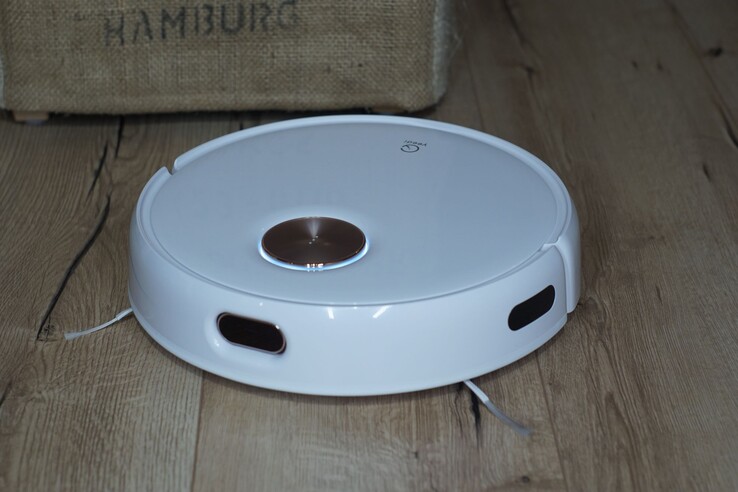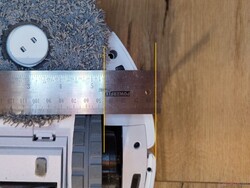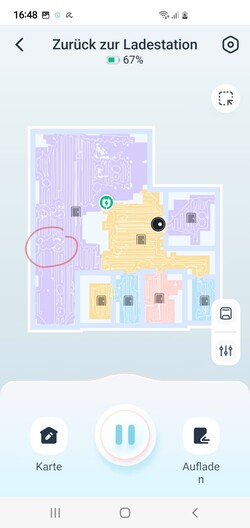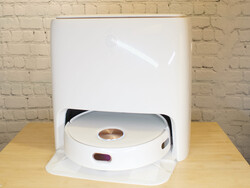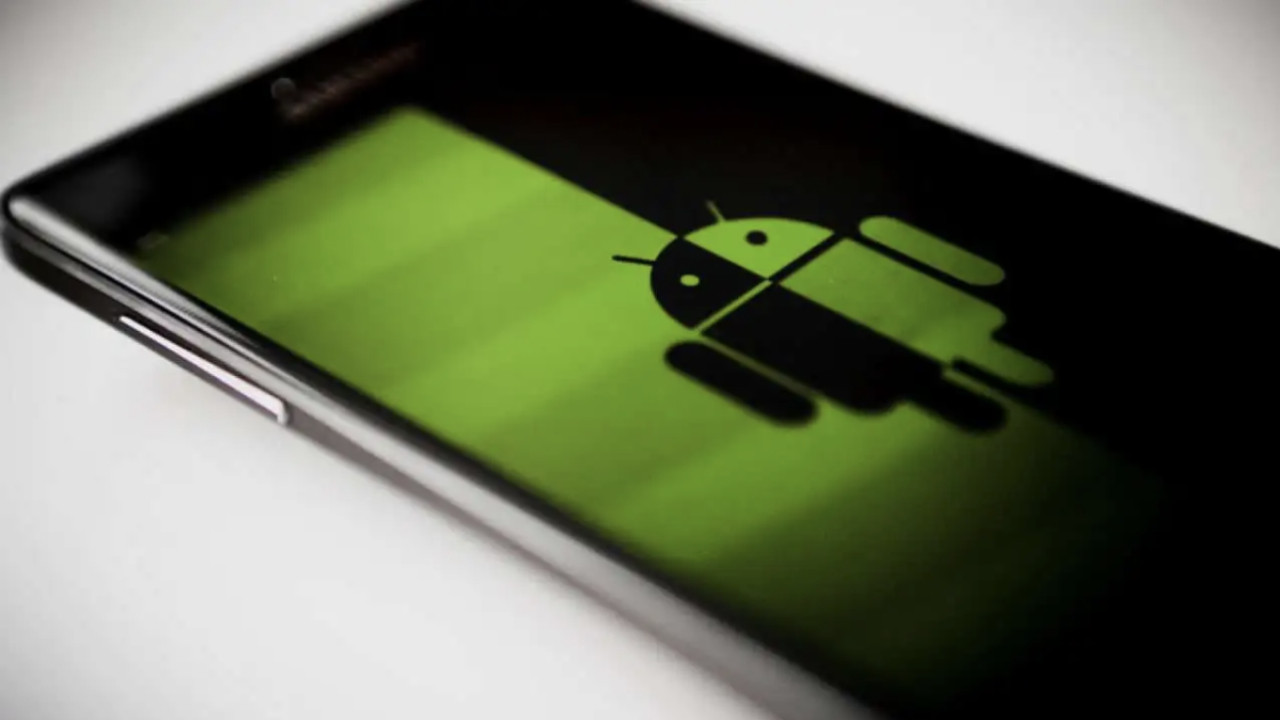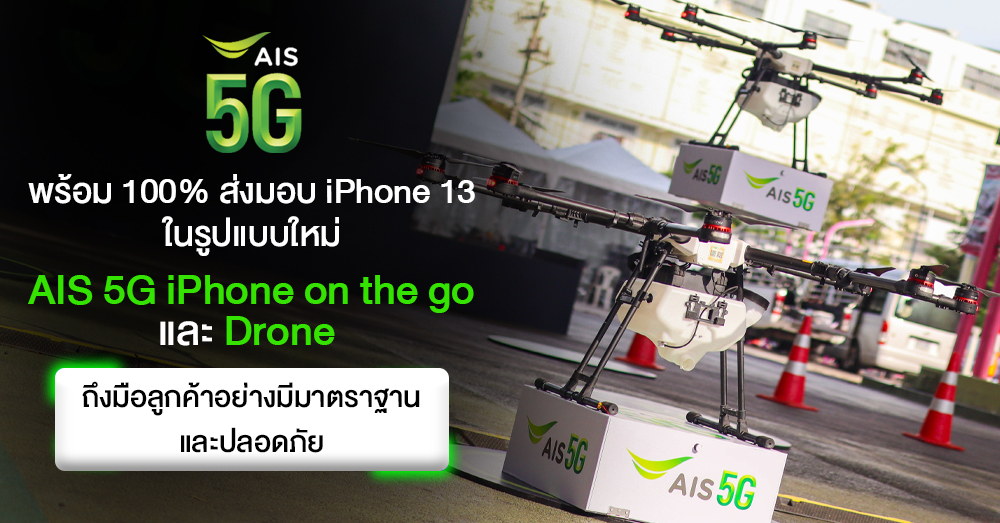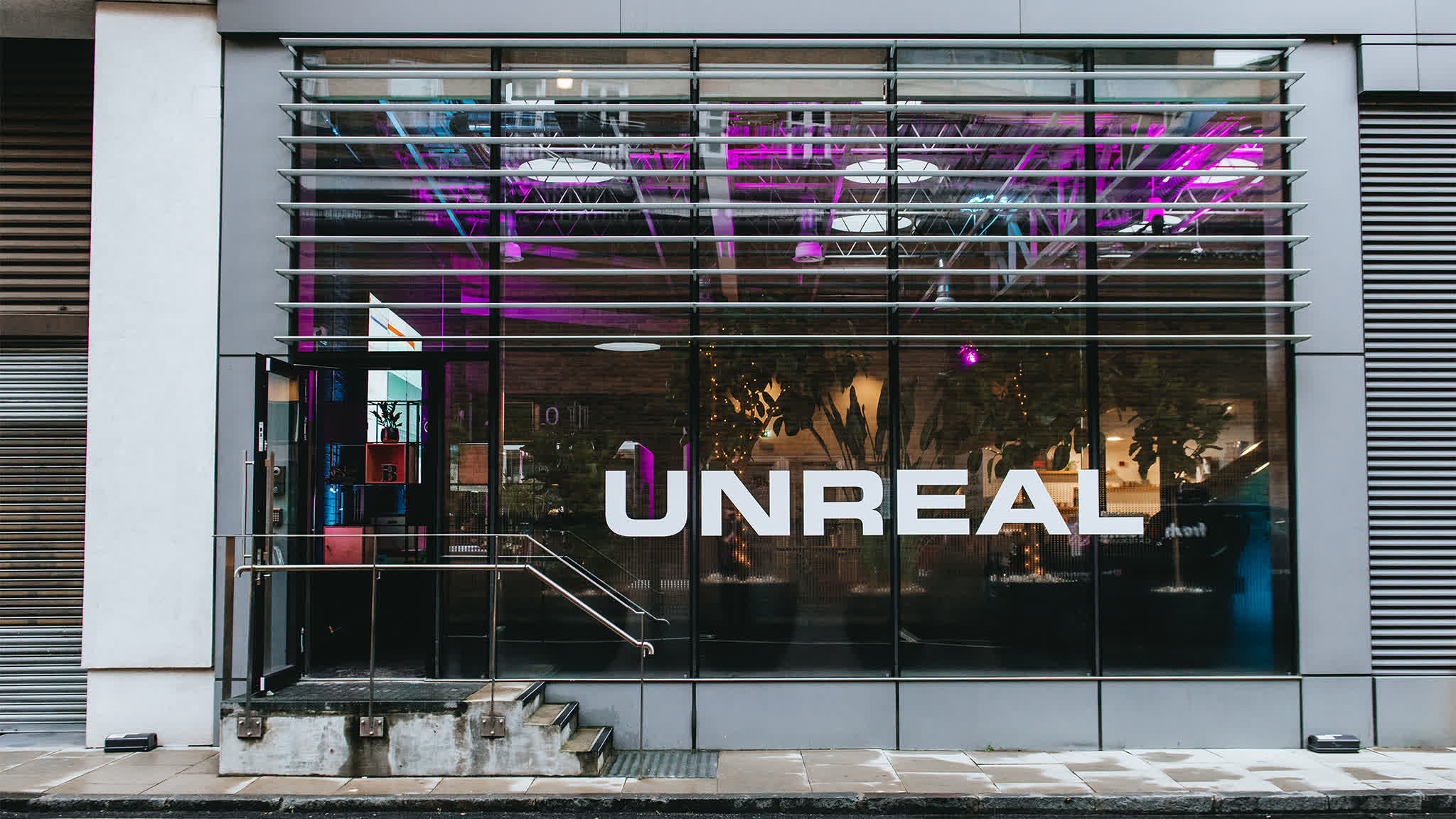The robot vacuum cleaner that vacuums and mops by itself. The new Yeedi Floor Station 3 can supposedly navigate households much more precisely thanks to its new ToF camera. With its rotating mop, dirt can be combatted thoroughly. But not everything works perfectly with Yeedi’s new domestic assistant quite yet.
“The ultimate mop robot – now even better” – this is what Yeedi promise with their new Floor 3 Station. With a suction power of up to 5,100 Pa, the robot mop vacuum cleaner can clean up a lot of dust. The rotating and oscillating mopping pads clean floors thoroughly and thanks to the mop station, user experience is significantly improved as well.
| Yeedi Floor Station 3 | |
|---|---|
| Product type | robot vacuum and mop |
| Design | round robot diameter 350 mm: height 84 mm Station with closed lid (B/T/H) 47 cm × 45 × 45 cm |
| Battery | 14,4 V; 5200 mAh; 74.88 Wh Type: S10-LI-144-520 4INR19/66-2 |
| Navigation | ToF camera with map storage and collision avoidance |
| Suction power | up to 5100 Pa (according to manufacturer) |
| Dust tank | 400 ml |
| Fresh water tank | 200 ml in the robot 4000 ml in the station |
| Charging times | 4 h 32 min (from 15 % to 100 %) |
| Connection | WLAN exclusively with 2,4 GHz |
| Special features | Map storage with manual backup and restoration on multiple floors Carpet recognition Alexa, Google Assistant and Siri voice control |
| Link to the manufacturer | Yeedi Floor 3 Station |
The Yeedi Floor 3 and the accompanying station are mostly glossy white in color. Thanks to the time-of-flight (ToF) camera at the front of the robot, it is built considerably flatter than its competitors with LiDAR cameras. The Yeedi Floor 3 is only 84 mm tall and has a diameter of 350 mm. This means the vacuum cleaner should have no problems cleaning under furniture. The base and the robot itself are decorated with a few rose gold accents. Its rounded edges and barely visible gaps give the robot a high-quality feel. However, as all the parts are made out of plastic and rubber, the ultra-shiny surfaces could probably get scratched with time.
The Yeedi Floor 3’s lid is completely removable and is held in place with multiple strong magnets. Underneath you can find the dust tank, which can hold 400 ml and has to be emptied regularly. There is a 200 ml water tank at the rear of the device and 3 side brushes on each side. This allows the robot to change directions more easily and clean floors more efficiently. If you look closely at the back of the vacuum cleaner, you can see a rubber tab – this is here so that an automatic emptying station can empty the dust tank. Unfortunately, the Floor 3 Station does not have this function.
The Yeedi Floor 3 Station comes with everything necessary but does not include any extras. Since all the consumables, such as filters, mop pads and brushes, have to be replaced at some point, you have to purchase these separately later down the line. The accessories supposedly last for around a year and a set costs approximately $84. The vacuum cleaner comes with an instruction manual, however, we found the Yeedi app to be so comprehensive that we didn’t even need to take a look at the paper instructions.
The various different components are grouped together in the device’s packaging. The dust and water tanks are already installed and you can put the rest together without the use of any tools. The ramp has to be inserted into the base, as well as the mop pads and brushes. As soon as the base is connected to the power, you can begin configuring the settings using the Yeedi app, which is available on Android and iOS devices. Here, we were faced with our first issue during our test – the device was unable to connect to our smartphone. Usually pressing the WiFi button would be enough to activate the robot’s setup mode. However, in our test, we ended up having to try our luck pressing multiple buttons on the base until a connection was made. We later found out that the Yeedi Floor 3 immediately activates setup mode when it’s in its station – but then you are unable to access the QR code on the device. After we managed to connect the robot to our WLAN, the rest of the setup went smoothly and without any problems. Then, we were onto creating our first map.
On our ground floor, which is around 75 square metres in size, theYeedi Vac 2 Protook around 2.5 hours to create a map – and only worked after the third attempt. The Yeedi Floor 3 was considerably quicker. After less than 10 minutes, the mapping was done and the robot had returned to its station. Thanks to its ToF camera on the front of the vacuum cleaner, the Yeedi Floor 3 only has to take a quick look around the room to create a detailed map. Since the device projects an invisible point grid, it can also work in the dark and was able to detect our floor-length mirrors.
The Yeedi app shows the approximate life expectancy of the consumables and you can use it to set the controls of the robot. This includes suction power in levels quiet, standard, maximum and maximum+, as well as water quantity in three different levels. The settings to control cleaning include a complete cleaning, the option to clean specific rooms, as well as zone cleaning. There are also multiple settings for the Floor 3 Station. All-in-all, the app is clear and intuitive. If you have previously owned a robot vacuum cleaner controlled via an app, then you will quickly get your bearings with the Yeedi app. The only option we find to be missing is the option to tell the robot to go to a specific location in the room. If the base is not easily accessed, then this makes servicing the device quite difficult.
One big critique about the app is the advert which is shown upon opening. Even though it only lasts 3 seconds and is skippable, we find it to be quite annoying, as we are already using the device which it is trying to advertise.
The Yeedi Floor 3 has the option to use a voice output, which can have the robot say which tasks it is currently working on and if it encounters any issues. This is available in multiple languages. During setup and servicing, the device also outputs clear instructions. The volume of the voice output can be controlled and it can also be switched off entirely.
The Yeedi Floor 3 cleans floors thoroughly. With high suction power and its rotating mop pads, it can remove lots of dirt. Small nuts and bolts are easily sucked up into the dust tank. The mop pads also remove lots of dirt – after about 10-20 square metres, the robot returns to its station to clean and wetten its mop pads. Even dried cat food, coffee and ketchup proved to be no problem for the Yeedi Floor 3 – but there were some exceptions. In our rooms with underfloor heating, the mop pads dried out too quickly – usually just before the robot returned to its station to clean them. In these situations, the device miscalculated the amount of water it needed. On laminate and wooden flooring without underfloor heating, the pads held their moisture much better. When everything goes to plan, the Yeedi Floor 3 leaves floors clean and streak-free. The robot vacuum tackles dust right up to the edges of the room thanks to its side brushes. The mop pads, however, leave a 4 cm wide strip of unwashed floor on each side.
The ToF navigation works reliably but not entirely without its issues. Obstacles like shoes, cables and toys are mostly identified by the ToF camera and the Yeedi avoids bumping into them. With the Yeedi Vac 2 Prowe were able to report how well the flat vacuum cleaner was able to clean under furniture – with the Yeedi Floor 3, this was not the case. It often refused to clean under furniture which it could easily fit under. The 84 mm tall robot cleaned under furniture with an 11 cm distance to the floor – and in turn, loses its advantage over vacuum cleaners with a LiDar tower. We hope this will soon be resolved in a firmware update.
In the long run, the robot can clean around 200-400 square metres without human assistance. The limiting factor here is having to empty and refill the various water tanks. The fresh and dirty water tanks can easily hold 4 litres of water.
Now coming to the true crux of the matter with the Yeedi Floor 3 Station. Technically, everything could be so easy – but, to keep the mop vacuum cleaner running, there are a few things you need to keep in check. The most important thing is making sure to empty the dust tank regularly because the Floor 3 Station doesn’t do this automatically. Apart from this, you also have to make sure to refill the water tank regularly and clean the brushes every now and then. To service the robot, it has to be removed from its station. It can release itself from its station at the touch of a button, but if you are there already, you’d be quicker just doing it yourself. The app doesn’t have an option for the robot to place itself into a servicing position. Furthermore, the Yeedi Floor 3 Station’s water tanks need to be emptied and refilled regularly. This means you should make sure to put the base somewhere that is easily accessible.
Next to everyday servicing, the device may also require extra repairs at some point. Positive aspects include, for example, how easily accessible the battery is. You just have to unscrew a few screws and the battery can be swapped out. The battery is an S10-LI-144.520 battery – the same one that can be found in many other mop robot vacuum cleaners on the market. This makes this spare part a relatively cheap and easy one to find.
With regards to the noise emissions of the Yeedi Floor 3 with station, you have to keep in mind that the device not only makes noise when in use and cleaning floors – the Yeedi Floor 3 Station also makes quite a bit of noise itself. When the robot was cleaning its mop pads, the Voltcraft SL-10 measured a volume of 54-64 dB(A) from one metre away. While drying its mop pads, we measured a volume of just under 40 dB(A), which in our eyes is not a bothersome volume. The sound of the mop pads being dried is a subtle whirring noise, which can easily be ignored.
When in use, the mop robot vacuum cleaner had a volume of at least 52 dB(A) when using the setting quiet and without the mop function. At full suction power, the volume rose to 75 dB(A). This could well be quite an annoying noise level for some – but it has to be noted that even normal vacuum cleaners have an average volume of around 80 dB(A).
| Set suction power | Volume |
|---|---|
| Quiet | 52 to 60 dB(A) without mop function 56 to 60 dB(A) with mop function |
| Standard | 58 to 62 dB(A) |
| Maximum | 66 to 70 dB(A) |
| Maximum+ | 72 to 75 dB(A) |
In standby mode, the Yeedi Floor 3’s station only requires 1 watt to maintain a steady charge of the base. The vacuum cleaner needs around 16 watts to charge its battery. After heating up, the mop pads need around 20 watts to be dried. The drying time can be set to 2, 3 or 4 hours. With 14 days of everyday use with 2 hours of drying, the device has an energy consumption of around 1.4 kWh. The Voltcraft SEM6000was used for these measurements. In comparison: Standard commercial vacuum cleaners use around 600-850 watts, which means in 2-3 hours of use, they use the same amount of energy.
The Yeedi Floor 3’s battery has a capacity of around 75 Wh. This means you should get runtimes of around 180 minutes. Depending on what settings you have picked, these times can be significantly shorter. With the device set on quiet and with the mop function turned off, the above-stated runtimes can be achieved. The settings maximum and maximum+ reduce the runtimes significantly. In our test, we measured an average cleaning speed of 1 square metre per minute. This means using the standard settings and with the mop function turned on, the vacuum cleaner can cover an area of over 120 square metres in one go. The true runtimes of the robot are hard to identify in combined use, as the base is charged automatically every time it returns to its station to clean its mop pads. However, after 130 minutes the battery was so low that the Yeedi Floor 3 had to take a longer break to charge.
During our 14-day test, the Yeedi Floor 3 Station used 1.4 kWh in total. Using an energy price of $0.42/kWh, this means the yearly cost to run the device comes to around $16. Consumable items like the side brushes, main brush and mop pads supposedly also last around a year. According to Yeedi, you can buy a pack of replacements for around $84. This means the total operating costs of the Yeedi Floor 3 Station come to around $100 a year.
Pros
+ 5100 Pa suction power
+Sleek design with a nice finish
+Self-cleaning station
+ Clear app
+ Alexa, Google Assistant and Siri voice controls
+ 84 mm flat
Cons
– App with adverts
– Doesn’t use its flat build to clean under furniture
– Self-cleaning station doesn’t have dust removal, even though the connection on the device is there
– Yearly operating costs of around $100
You certainly can’t complain about the Yeedi Floor 3 and the Yeedi Floor 3 Station’s hardware. The vacuum cleaner and its station are built well, have a high-quality feel and both devices have been technically perfected. The Yeedi Floor 3 cleans thoroughly with the help of its ToF camera – as long as it doesn’t have to clean under furniture.
The software is the actual weak point of the device. Here, the manufacturer should really adjust a few aspects to avoid frustrating any customers. Problems such as dried-out mop pads could be easily sorted with a software update. Additionally, there is the missing automatic emptying of the dust tank. Considering the attachment for this is already installed on the device, we can only assume that a new and updated station will be on offer soon.
As an early user of the Yeedi Floor 3 Station shortly after its release, you really felt like you were taking part in an Open Beta Test.
Of course, every household is different and the manufacturer can’t plan for every single eventuality. From our experience with other Yeedi devices, we can only assume there will be multiple software updates for the Yeedi Floor 3 Station. We were very happy about Yeedi’s customer support, who always responded to our emails quickly and answered all of the questions we had.
The Yeedi Floor 3 Station is not yet available at major retailers like Amazon in the US. When it does become available, it will retail for around $842.
Transparency
The present review sample was given to the author by the manufacturer free of charge for the purposes of review. There was no third-party influence on this review, nor did the manufacturer receive a copy of this review before publication. There was no obligation to publish this review.
Editor of the original article: Marc Herter – Tech Writer – 212 articles published on Notebookcheck since 2021
From an early age I liked to thoroughly examine all kinds of devices to see how they worked, which also involved taking my own devices apart and therefore not always to the delight of my parents. Nevertheless, with my grandfather’s support, I became a computer and electronics tinkerer. With the family PC and Lego Mindstorms, my interested in software and programming took off, and I am currently an engineering program student. I enjoy building all sorts of gadgets with Arduino and 3D printers, and I still like to put electronic devices through their paces. By joining the Notebookcheck editorial team, I have been able to turn my hobby into a profession.
Translator: Daisy Dickson – Translator – 8 articles published on Notebookcheck since 2023
Originally from Scotland, I grew up and lived in Germany until I completed my high school qualifications before moving back to Scotland to complete my university studies. Growing up bilingual led me to form a close relationship with the English and German languages, often working in the fields of teaching and translation. Most of my childhood was shaped by playing around on new consoles, computers and gadgets and getting to grips with the new craze of the internet and smartphones. This interest has stayed with me well into adulthood. Nowadays, I live in Glasgow and work as a freelance translator and digital media coordinator. I have been translating for Notebookcheck since early 2023.
Marc Herter, 2023-03- 8 (Update: 2023-03- 8)
Note: This article have been indexed to our site. We do not claim legitimacy, ownership or copyright of any of the content above. To see the article at original source Click Here



